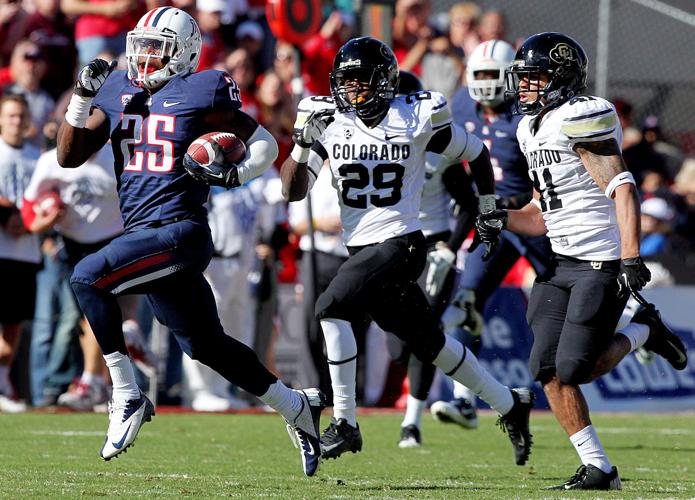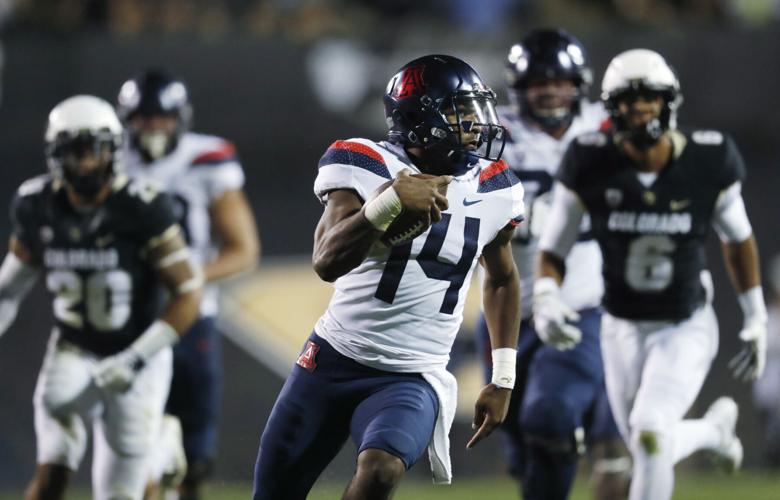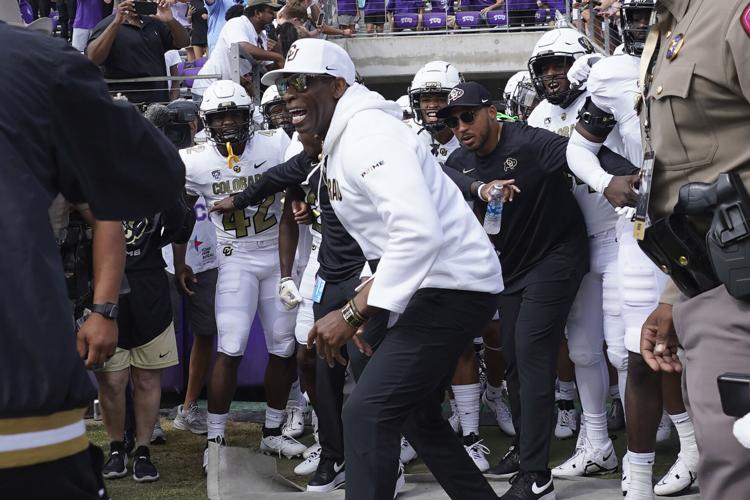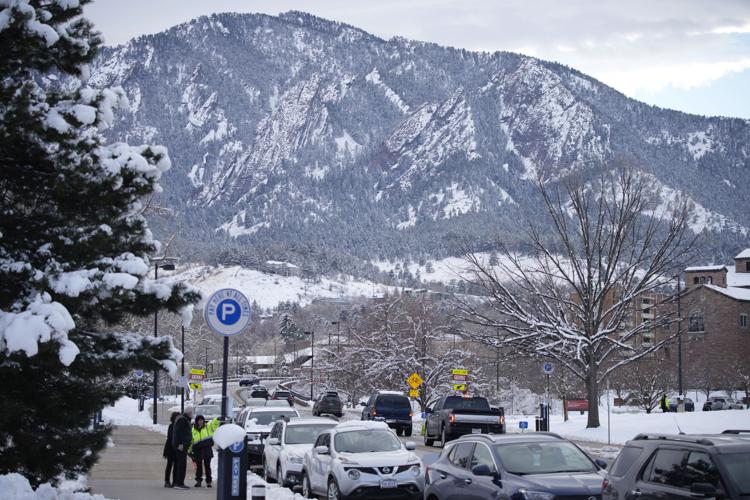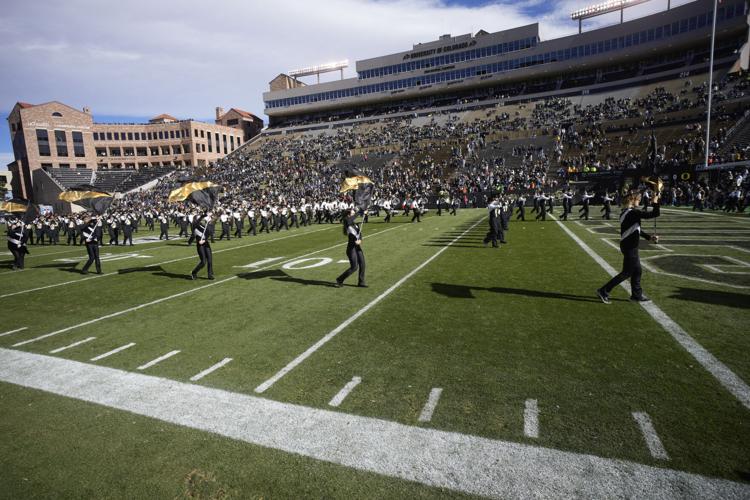Editor’s note: This is part of the Star’s ongoing “Big 12 Blitz” series, where we introduce U of A fans to the on- and off-field need-to-know details surrounding each member of the new 16-team Big 12. Today: The University of Colorado, located in Boulder, Colorado.
The Star's Big 12 Blitz is presented by Tucson Appliance Company.

Tucson Appliance Company has something for everyone! We specialize in new, reconditioned, scratch-and-dent, and high-end appliances. Known for…
The Four Corners schools were not united in their move to the Big 12. Proof? Colorado jumped to the Big 12 eight days before Arizona, ASU and Utah.
Why were the Buffaloes so eager? It goes beyond the $2.5 million “bonus’’ they were given to join the league. It could be as simple as wins and losses. It could be that they were in over their heads in the Pac-12, Deion Sanders or no Deion Sanders.

Arizona’s Ka’Deem Carey breaks ahead of Colorado’s Harrison Hunter and Terrel Smith for a long third-quarter run during Arizona’s 2012 win over the Buffaloes. Carey ran for a school and Pac-12 record 366 yards that day at Arizona Stadium in Tucson.
Colorado was the Pac-12’s worst football team of its brief 13-year run, 2011-2023. Here are the bottom tier of the conference standings:
- Colorado, 28-85.
- California, 37-75.
- Oregon State, 38-74.
- Arizona, 43-69.

Greg Hansen is the longtime sports columnist for the Arizona Daily Star and Tucson.com.
The lure of playing Kansas, Oklahoma State and Iowa State is surely preferable than yearly matchups against Oregon, USC and Washington. The Buffaloes were an inept 3-29 against the Ducks, Trojans and Huskies in their oft-torturous Pac-12 days.
In contrast, football in the Big 12 has been sunshine to Colorado. Believe it or not, the Buffaloes do not have a losing record to any of the schools it joins in the Big 12. Here’s the happy history (heading into the 2024 season) of CU v. holdover Big 12 members:
- Iowa State, 49-15-1.
- Kansas State, 45-20-1.
- Kansas, 42-25-3.
- Oklahoma State, 26-20-1.
- BYU, 8-3-1.
- Baylor, 9-7.
- Cincinnati and Houston, 1-0.
- TCU and West Virginia, 1-1.
- Texas Tech, 5-5.
(Colorado had never played UCF until last month).
Previous generations of football fans view the Buffaloes much differently than those of the Pac-12 years, hardscrabble seasons in which CU changed head coaches five times in 12 years: Jon Embry to Mike McIntyre to Mel Tucker to Karl Dorrell to Sanders.
How bad was CU as a member of the Pac-12?

Khalil Tate rushed for 327 yards, an FBS record for a quarterback, and accounted for five touchdowns to help Arizona hold off Colorado 45-42 at Folsom Field in Boulder, Colorado, in 2017
It permitted Arizona to establish two school records that might stand for 100 years: UA running back Ka’Deem Carey rushed for 366 yards against the Buffaloes in a 2012 game in Tucson, and Wildcat quarterback Khalil Tate set an NCAA record for quarterbacks by gaining 327 yards in a 2017 victory at Folsom Field. (Not only that, Tate completed 12 of 13 passes that night).
But if you judge the 16 members of the new Big 12 by their entire football history, Colorado probably ranks No. 1 as a football school. Its only challenger would be BYU (a Top 25-type football program since 1980).
TCU and Utah – hot stuff, for sure – have undeniably been Top 25 programs the last 20 years. But in the 1900s, the Utes and Horned Frogs were not on the football map. Arizona State was smoking hot from 1956-1986, but has since been fair to middlin.’
Colorado has won 19 conference championships (Arizona, by comparison, has won six, none in the past 60 years). CU has produced a Heisman Trophy winner (Rasaan Salaam, 1994), won a national co-championship (1990) and has more lifetime victories, 670, than any team in the Big 12 except West Virginia’s 693.

Colorado’s 2023 football season under coach Deion Sanders started with a bang — a 45-42 win over then-defending-national-runner-up TCU, a Big 12 opponenet, in Fort Worth, Texas, on national television. But it ended with just three more wins in 11 tries — a parallel of sorts to the Buffaloes’ 13-year tenure in the Pac-12.
The must-ask question is: Can Colorado resuscitate its once proud football image, one produced under Hall of Fame coach Bill McCartney, who coached the Buffaloes to records of 11-1, 11-1, 11-1-1, 10-2 and 10-2 in an incandescent period of success, 1989-96?
The pressure is on Neon Deion to do so.
McCartney was so beloved, so valued at CU, that after being ranked No. 1 in 1990 the school signed him to a 15-year contract, believed at the time to be the longest contract ever signed by a college football coach.
Alas, McCartney’s fire ebbed and he retired from coaching in 1994. He was only 54. CU is working to rekindle the McCartney magic, and the Big 12 suits the Buffaloes much better than the Pac-12 did.
For one thing, the Colorado fan-base is more familiar with Iowa State than it was with UCLA or Stanford. CU always seemed like a stranger on the West Coast.
Few in the Pac-12 appreciated its history and potential.
Boulder is a special college town. Game day at Folsom Stadium was, in my opinion, the best game-day experience in Pac-12 football, even during a period in which CU was the league’s worst football franchise. It goes far beyond Ralphie the Buffalo running a lap around the field before the game and at halftime.

After a winter storm swept over the intermountain West, the Flatirons are covered in snow Saturday, Feb. 12, 2022, in Boulder, Colorado.
The setting is hard to match. The Flatiron Mountains are up-close. CU’s campus is built in the foothills. On a scale of 1-to-10 for scenery, it’s an 11. Moreover, it doesn’t rain in Boulder as it does at Oregon’s Autzen Stadium and Washington’s Husky Stadium, and fans aren’t fickle as they are at USC and UCLA, where no-shows sometimes outnumber occupied seats.
In Boulder, the Buffaloes are the only game in town.
The Big 12 doesn’t have a true football Cathedral, nothing like the Horseshoe at Ohio State, the Big House at Michigan, Death Valley at LSU and Happy Valley at Penn State.

Folsom Field readies for a Colorado home football game on Nov. 5, 2022, in Boulder, Colorado.
But last season, every school except West Virginia (86 percent) drew at least 90 percent capacity at home football games. Cincinnati, Kansas State, Oklahoma State and TCU all drew 100 percent capacity.
With a cozy seating capacity of 53,180, Folsom Field has the promise of being the stadium of dread for visiting Big 12 teams, and not just because the Ralphie is running on the sidelines again.
Arizona hosts the Buffaloes Saturday in football as Big 12 cohorts. A charter Big 12 member, Colorado is back (across all sports) home after a decade-plus moonlighting in the Pac-12.
Big 12 Blitz is the Star's way of introducing you — the discerning Arizona Wildcat season ticket holder, would-be road-tripper or cardinal and navy-clad die-hard — to the teams, towns, campuses and more UA coaches, athletes and supporters will get to know across the new Big 12 landscape.


